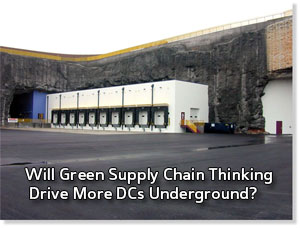Underground distribution centers have been around for some time, but, in general, have been used primarily for storage, such as archived documents, rather than distribution, which required more intensive logistics operations. Seems as if that is starting to change, a trend that may accelerate as the Green Supply Chain benefits of moving to “underground” start to impact supply chain decisions.
In 2008, for example, food giant Kraft, which had been using some underground DC space for low-volume storage for decades, upped the ante by opening a new 400,000 square foot facility near Springfield, MO.
The facility was “designed with energy efficiency and sustainability in mind,” the company said at the time.
Dramatically Reduced Energy Costs
In general, underground DC space does not come from natural caves, which are usually not physically well suited to development and have issues with water and dampness. Instead, these facilities are developed from abandoned mines or quarries that once produced limestone or salt.
The natural temperature of these underground spaces is generally in the 60-65 degree range year round, with low humidity. As a result, energy costs for these facilities are much lower than a standard above-ground DC. For example, Kraft estimates that the electricity costs for its underground facility, which is a refrigerated space kept at 36 degrees, is 65% lower than a comparable above-ground building. In addition to the energy savings, there would be a corresponding reduction in associated CO2 emissions.
Unlike real caves, these facilities are also “bat free.”
Much of the available underground space is in the Missouri area, around both Springfield and Kansas City. One operator there, Springfield Underground, says it has 2.2 million square feet of space in place, and more under development. In the case of Kraft’s DC, for example, the facility space was created with a solid limestone roof and ceiling, limestone structural columns and walls that are 35% limestone. Recycled material from quarry operations provided building fill material.
Other operators in the same general area include Bussen and SubTropolis. Bussen has at least 1 million square feet of space developed, and SubTropolis, not far from the growing logistics hub of Kansas City, boasts some 4 million total square feet underground.
Space is often developed specifically to meet a given shipper’s needs, but, in some cases, DC space is immediately available, either as a result of an existing client leaving or, in some cases, developed “on spec.” Bussen, for example, is currently promoting a 140,000 square-foot facility it created in anticipation of a future client. Bussen notes such clients as Kuna Food Service, Sensient Flavors, and United Fulfillment. Mayflower Transit and United Van Lines both run a huge cross dock facility there.
 The Missouri area is not the only such area for underground DC space. Southern Indiana also has hundreds of thousands of square feet of empty space from underground limestone quarries. The Missouri area is not the only such area for underground DC space. Southern Indiana also has hundreds of thousands of square feet of empty space from underground limestone quarries.
The developers obviously need to work with local water and sewage authorities to make sure those services are provided to meet individual client requirements.
In addition to the energy savings and carbon emissions reduction, underground DC developers say that the space itself can often be leased at a discount per square foot as much as 35% versus above-ground space (though more space may be required, as ceiling heights, in general, are more limited than above-ground buildings). These also cite productivity benefits as operators work in a more comfortable environment, dramatically reduced risk of damage from tornadoes or other storms, little or no external maintenance costs, and significantly reduced issues with building security and theft.
It won’t be for everyone, and most areas don’t have such developments nearby, but we expect more companies to look at these underground facilities, especially under a cap-and-trade regime for carbon emissions.
Do you have experience with underground distribution facilities? What are the downsides or limitations? Do you expect more mainstream use of them with Green Supply Chain initiatives? Let us know your thoughts at the Feedback button below.

|